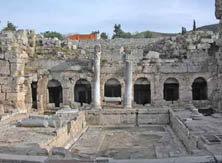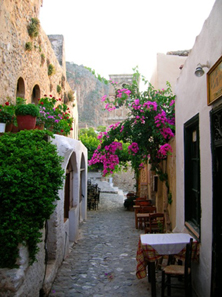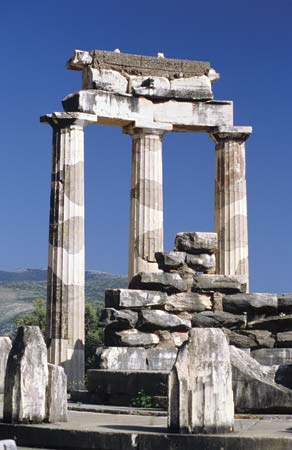Private
Tours: Five Days
TOUR
1: ANCIENT
CORINTH, CANAL, ACRO-CORINTH, THEATER OF EPIDAURUS, NAFPLION,
MYCENAE, ANCIENT SPARTA & THE BYZANTINE FORTIFIED CASTLE
OF MYSTRAS, MONEMVASIA, ANCIENT OLYMPIA, DELPHI (Four
overnight stays in Nafplion, Sparta, Movemvasia, and Olympia)
includes
a visit to: Ancient Corinth (where you can
see the Long Walls that begin at the summit of Acro-Corinth
and descend all the way to Lechaion, the artificial harbour
on the Corinthian Gulf, the Agora, the Dorian Temple of Appollo
[6th c. BC with 1st c. AD restorations], the museum which
contains mosaic floors, Mycenaean and Corinthian pottery,
terra cotta sphinxes, statues of two supernatural beings,
relief plaques, the Roman head of the goddess Tyche and small
objects of various kinds, and the Bima where St Paul preached),
The Canal (which is about 6 km long and connects
the Aegean Sea with the Ionian Sea; its width upon completion
was 25 meters, and 8 meters deep), Acro-Corinth
(the fortress acropolis of Ancient Corinth and Medieval Corinth,
being on a steep of a rocky hill 575 meters high at its highest
peak, with uninterrupted views across the Corinthian and Saronic
Gulfs. It has been a fortified citadel for the Mycenaens,
Archaic Greeks, Macedonians, Romans, Byzantines, Franks, Venetians,
Ottomans and eventually back to the Hellenes following the
Greek War of Independence), The Theater of Epidaurus
(which is marbeled for its exceptional acoustics, which permit
almost perfect intelligibility of unamplified spoken word
from the proscenium or skene to all 15,000 spectators, regardless
of their seating), Nafplion (where you will
climb up the 999 steps to the Venetian fortress of Palamidi
crowning the city, wander around the battlements of Acronafplia
and pop over to the fortified island, Bourtzi), Mycenae
(where you will see the Cyclopean Walls, the Grave Circle
A with 6 royal tombs, courtiers’ houses, sanctuaries, the
Grave Circle B with 14 royal tombs and 12 tombs of private
citizens, the Treasure of Atreus also known as the beehive
tomb of Agamemnon, and the Lions Gate), Ancient Sparta
(some ruins remain of the ancient acropolis: The Sanctuary
of Artemis Orthia [6th c. BC], The Tomb of Leonidas [5th c.
BC], the Olive Museum, and the Menelaion. The museum with
findings from the area is housed in a neoclassical building
in the centre of the town), The Byzantine Fortified
Castle of Mystras (some of the most important monuments
of the site of Mystra are: The Castle, The Cathedral of Saint
Demetrios, The Church of St. Theodore, The Church of Aghia
Sophia, The Monastery of Our Lady Perivleptos, The Church
of Our Lady Evagelistria, The Monastery of Our Lady Pantanassa,
The Palaces of The Mystra Despotes), Monemvasia,
Ancient Olympia where you will see The Archaeological
Site (the Prytaneion [where ceremonies honoring the
winners took place], the Philippeion, next to it the Heraion
[a Doric Temple dedicated to Hera], the Pelopion [an altar
dedicated to Pelops from whom the Peloponnese is named], the
Doric Temple of Zeus [472 BC]), The Archaeological
Museum (here are displayed findings from the area,
and among them there are the stone head of Hera, Praxiteles’
marble statue of Hermes [330 BC], the Victory by Paionios
[421 BC], Miltiades’ helmet, the terra cotta group of Zeus
carrying Ganymede, and the sculptures from the pediments and
metopes of the Temple of Zeus, among the most important works
of Classical art. There are also pottery, terra cotta and
bronze figurines, and votive offerings from the sanctuary),
and The Museum of the Olympic Games (it contains
mementos connected with the history of the Games and a unique
series of postage stamps, designed by Papastephanos – Provatakis
commemorating the Games), The Famous Sanctuary of
Delphi (which was the site of the Delphic Oracle,
the most important oracle in the Classical Greek world).
TOUR
2: ANCIENT CORINTH, CANAL, MYCENAE, NAFPLION, ANCIENT SPARTA
& THE BYZANTINE FORTIFIED CASTLE OF MYSTRAS, ANCIENT OLYMPIA,
DELPHI, THE MONASTERIES OF METEORA & THE BATTLE GROUND OF
THERMOPYLAE (Four overnight stays in Sparta, Olympia,
Delphi, and Meteora)
includes
a visit to: Ancient Corinth (where you can
see the Long Walls that begin at the summit of Acro-Corinth
and descend all the way to Lechaion, the artificial harbour
on the Corinthian Gulf, the Agora, the Dorian Temple of Appollo
[6th c. BC with 1st c. AD restorations], the museum which
contains mosaic floors, Mycenaean and Corinthian pottery,
terra cotta sphinxes, statues of two supernatural beings,
relief plaques, the Roman head of the goddess Tyche and small
objects of various kinds, and the Bima where St Paul preached),
The Canal (which is about 6 km long and connects
the Aegean Sea with the Ionian Sea; its width upon completion
was 25 meters, and 8 meters deep), Mycenae
(where you will see the Cyclopean Walls, the Grave Circle
A with 6 royal tombs, courtiers’ houses, sanctuaries, the
Grave Circle B with 14 royal tombs and 12 tombs of private
citizens, the Treasure of Atreus also known as the beehive
tomb of Agamemnon, and the Lions Gate), Nafplion
(where you will climb up the 999 steps to the Venetian fortress
of Palamidi crowning the city, wander around the battlements
of Acronafplia and pop over to the fortified island, Bourtzi),
Ancient Sparta (The Sanctuary of Artemis
Orthia [6th c. BC], The Tomb of Leonidas [5th c. BC], The
Olive Museum , and The Menelaion. The museum with findings
from the area is housed in a neoclassical building in the
centre of the town) and finally The Byzantine Fortified
Castle of Mystras (some of the most important monuments
of the site of Mystra are: The Castle, The Cathedral of Saint
Demetrios, The Church of St. Theodore, The Church of Aghia
Sophia, The Monastery of Our Lady Perivleptos, The Church
of Our Lady Evagelistria, The Monastery of Our Lady Pantanassa,
The Palaces of The Mystra Despotes), Ancient Olympia
where you will see The Archaeological Site
(the Prytaneion [where ceremonies honoring the winners took
place], the Philippeion, next to it the Heraion [a Doric Temple
dedicated to Hera], the Pelopion [an altar dedicated to Pelops
from whom the Peloponnese is named], the Doric Temple of Zeus
[472 BC]), The Archaeological Museum (here
are displayed findings from the area, and among them there
are the stone head of Hera, Praxiteles’ marble statue of Hermes
[330 BC], the Victory by Paionios [421 BC], Miltiades’ helmet,
the terra cotta group of Zeus carrying Ganymede, and the sculptures
from the pediments and metopes of the Temple of Zeus, among
the most important works of Classical art. There are also
pottery, terra cotta and bronze figurines, and votive offerings
from the sanctuary), and The Museum of the Olympic
Games (it contains mementos connected with the history
of the Games and a unique series of postage stamps, designed
by Papastephanos – Provatakis commemorating the Games), The
Famous Sanctuary of Delphi (which was the
site of the Delphic Oracle, the most important oracle in the
Classical Greek world), The Monasteries of Meteora
(most of the monasteries were built or renovated
in the 16th century. Nowadays six are in use. A good road
leads from Kalambaka to the monasteries with their wonderful
wall paintings, ecclesiastical treasures, rich libraries with
precious manuscripts, and exquisite icons. Also the movie
“For Your Eyes Only’ with JAMES BOND was filmed there) and
finally Thermopylae (with a modern-day monument
of King Leonidas I of Sparta. Thermopylae means “hot gates”
in Greek. This is derived from the myth that Heracles had
jumped into the river in an attempt to wash off the Hydra
poison imbibed in the cloak that he could not take off. The
river was said to have turned hot and stayed that way ever
since).
TOUR
3: ANCIENT CORINTH, CANAL, ACRO-CORINTH, THEATER OF EPIDAURUS,
NAFPLION, MYCENAE, ANCIENT OLYMPIA, DELPHI, THE MONASTERIES
OF METEORA & THE BATTLE GROUND OF THERMOPYLAE
(Four overnight stays in Nafplion, Olympia, Delphi, and Meteora)
includes
a visit to: Ancient Corinth (where you can
see the Long Walls that begin at the summit of Acro-Corinth
and descend all the way to Lechaion, the artificial harbour
on the Corinthian Gulf, the Agora, the Dorian Temple of Appollo
[6th c. BC with 1st c. AD restorations], the museum which
contains mosaic floors, Mycenaean and Corinthian pottery,
terra cotta sphinxes, statues of two supernatural beings,
relief plaques, the Roman head of the goddess Tyche and small
objects of various kinds, and the Bima where St Paul preached),
The Canal (which is about 6 km long and connects
the Aegean Sea with the Ionian Sea; its width upon completion
was 25 meters, and 8 meters deep), Acro-Corinth
(the fortress acropolis of Ancient Corinth and Medieval Corinth,
being on a steep of a rocky hill 575 meters high at its highest
peak, with uninterrupted views across the Corinthian and Saronic
Gulfs. It has been a fortified citadel for the Mycenaens,
Archaic Greeks, Macedonians, Romans, Byzantines, Franks, Venetians,
Ottomans and eventually back to the Hellenes following the
Greek War of Independence), The Theater of Epidaurus
(which is marbeled for its exceptional acoustics, which permit
almost perfect intelligibility of unamplified spoken word
from the proscenium or skene to all 15,000 spectators, regardless
of their seating), Nafplion (where you will
climb up the 999 steps to the Venetian fortress of Palamidi
crowning the city, wander around the battlements of Acronafplia
and pop over to the fortified island, Bourtzi), Mycenae
(where you will see the Cyclopean Walls, the Grave Circle
A with 6 royal tombs, courtiers’ houses, sanctuaries, the
Grave Circle B with 14 royal tombs and 12 tombs of private
citizens, the Treasure of Atreus also known as the beehive
tomb of Agamemnon, and the Lions Gate), Ancient Olympia
where you will see The Archaeological Site
(the Prytaneion [where ceremonies honoring the winners took
place], the Philippeion, next to it the Heraion [a Doric Temple
dedicated to Hera], the Pelopion [an altar dedicated to Pelops
from whom the Peloponnese is named], the Doric Temple of Zeus
[472 BC]), The Archaeological Museum (here
are displayed findings from the area, and among them there
are the stone head of Hera, Praxiteles’ marble statue of Hermes
[330 BC], the Victory by Paionios [421 BC], Miltiades’ helmet,
the terra cotta group of Zeus carrying Ganymede, and the sculptures
from the pediments and metopes of the Temple of Zeus, among
the most important works of Classical art. There are also
pottery, terra cotta and bronze figurines, and votive offerings
from the sanctuary), and The Museum of the Olympic
Games (it contains mementos connected with the history
of the Games and a unique series of postage stamps, designed
by Papastephanos – Provatakis commemorating the Games), The
Famous Sanctuary of Delphi (which was the
site of the Delphic Oracle, the most important oracle in the
Classical Greek world), The Monasteries of Meteora
(most of the monasteries were built or renovated in the 16th
century. Nowadays six are in use. A good road leads from Kalambaka
to the monasteries with their wonderful wall paintings, ecclesiastical
treasures, rich libraries with precious manuscripts, and exquisite
icons. Also the movie “For Your Eyes Only’ with JAMES BOND
was filmed there) and finally Thermopylae
(with a modern-day monument of King Leonidas I of Sparta.
Thermopylae means “hot gates” in Greek. This is derived from
the myth that Heracles had jumped into the river in an attempt
to wash off the Hydra poison imbibed in the cloak that he
could not take off. The river was said to have turned hot
and stayed that way ever since).

|



